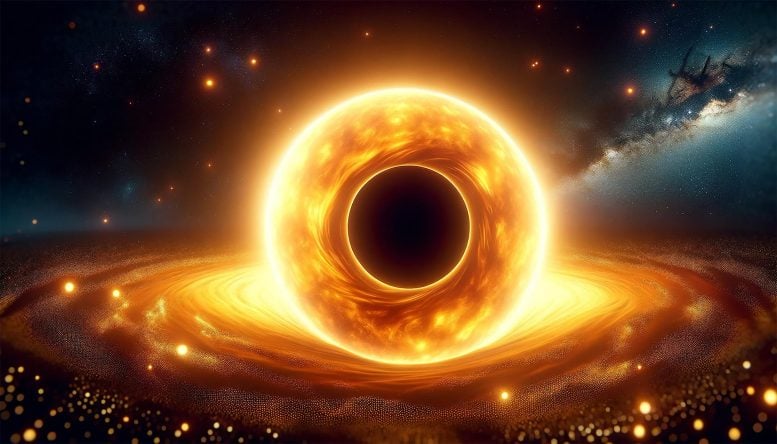
An international research team suggests that “Hawking stars,” stars with central primordial black holes, could mimic normal stars and aid in exploring dark matter and the early universe. Credit: SciTechDaily.com
In a hypothetical scenario, small, primordial black holes could be captured by newly forming stars. An international team, led by researchers at the Max Planck Institute for Astrophysics, has now modeled the evolution of these so-called “Hawking stars” and found that they can have surprisingly long lifetimes, resembling normal stars in many aspects. Asteroseismology could help to identify such stars, which in turn could test the existence of primordial black holes and their role as a component for dark matter.
Let’s do a scientific exercise: If we assume that a large number of very small black holes were created just after the Big Bang (so-called primordial black holes), some of them might be captured during the formation of new stars. How would this affect the star during its lifetime?
“Scientists sometimes ask crazy questions in order to learn more,” says Selma de Mink, director of the stellar department at the Max Planck Institute for Astrophysics (MPA). “We don’t even know whether such primordial black holes exist, but we can still do an interesting thought experiment.”
Primordial black holes would have formed in the very early Universe with a wide range of masses, from some as small as an asteroid up to thousands of solar masses. They could constitute an important component of dark matter, as well as being the seeds for the supermassive black holes at the center of present-day galaxies.
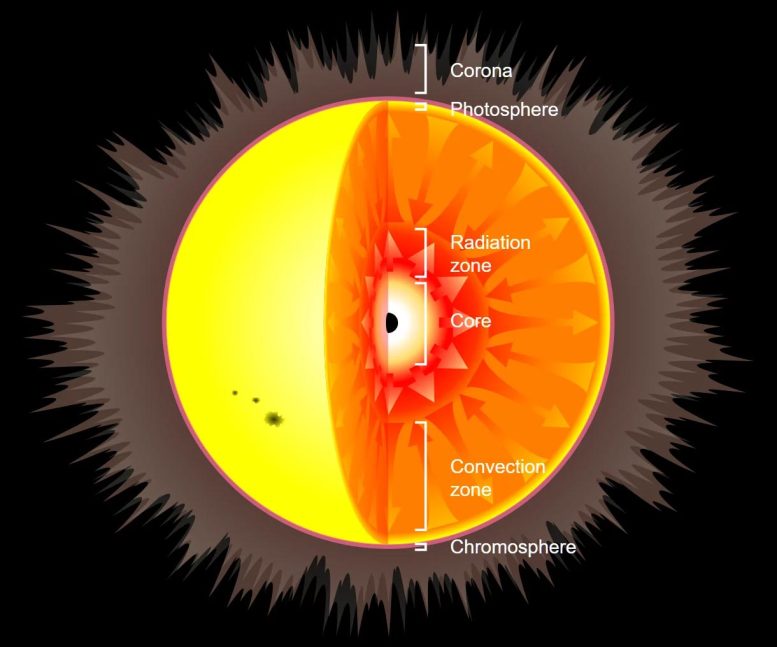
Artist’s impression of putting a small black hole at the center of the Sun in a thought experiment. Credit: © MPA, background image: Wikimedia/Creative Commons.
With a very small probability, a newly forming star could capture a black hole with the mass of an asteroid or a small moon, which would then occupy the star’s center. Such a star is called a “Hawking star,” named after Stephen Hawking, who first proposed this idea in a paper in the 1970s. The black hole at the center of such a Hawking star would grow only slowly, as the infall of gas to feed the black hole is hampered by the outflowing luminosity.
An international team of scientists has now modeled the evolution of such a star with various initial masses for the black hole and with different accretions models for the stellar center. Their astonishing result: when the black hole mass is small, the star is essentially indistinguishable from a normal star.
“Stars harboring a black hole at their center can live surprisingly long,” says Earl Patrick Bellinger, MPA Postdoc and now Assistant Professor at Yale University, who led the study. “Our Sun could even have a black hole as massive at the planet Mercury at its center without us noticing.”
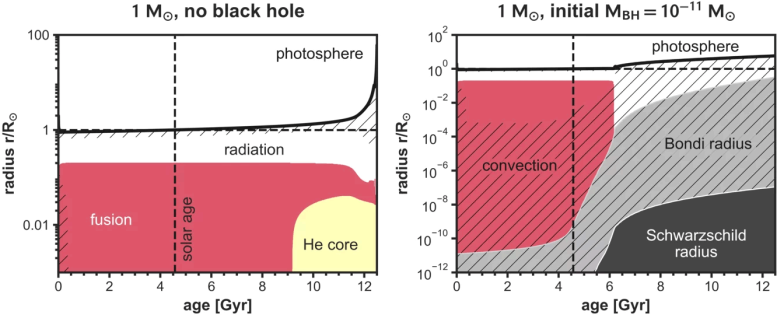
These two diagrams show the radial evolution of a star with the mass of the Sun without (left) and with (right) a black hole with an initial mass similar to an asteroid. The black solid line shows the radius of the photosphere, the vertical dashed line the current age of the Sun. The red region shows where hydrogen is converted to helium in nuclear fusion, which provides the bulk of the solar luminosity until the black hole starts to grow noticeably (black region; for lower ages the black hole is too small to be seen in this plot). The black hole drives convection (hatches), which mixes the innermost parts of the star. Note the different scaling of the y-axes Credit: © MPA
The main difference between such a Hawking star and a normal star would be near the core, which would become convective due to the accretion onto the black hole. It would not alter the properties of the star at its surface and would elude present detection capabilities. However, it could be detectable using the relatively new field of asteroseismology, where astronomers are using acoustic oscillations to probe the interior of a star.
Also in their later evolution, in the red giant phase, the black hole might lead to characteristic signatures. With upcoming projects such as PLATO, such objects might be discovered. However, further simulations are needed to determine the implications of putting a black hole into stars of various masses and metallicities.
If primordial black holes were indeed formed soon after the Big Bang, looking for Hawking stars could be one way to find them. “Even though the Sun is used an exercise, there are good reasons to think that Hawking stars would be common in globular clusters and ultra-faint dwarf galaxies,” points out Professor Matt Caplan at Illinois State University, co-author of the study.
“This means that Hawking stars could be a tool for testing both the existence of primordial black holes, and their possible role as dark matter.”
Reference: “Solar Evolution Models with a Central Black Hole” by Earl P. Bellinger, Matt E. Caplan, Taeho Ryu, Deepika Bollimpalli, Warrick H. Ball, Florian Kühnel, R. Farmer, S. E. de Mink and Jørgen Christensen-Dalsgaard, 13 December 2023, The Astrophysical Journal.
DOI: 10.3847/1538-4357/ad04de



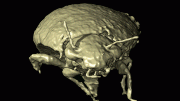


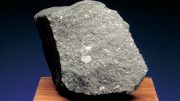


This is not even remotely science. However I want to point out it is so kind of the standard modelist and hypotheoeretical mathematician “cosmologists” to admit that the classical black hole is dead and does not exist. That way you can put fake models of z pinches inside of stars. For the next step they can learn a Lerner-Scott model of an electric star and how the Universe actually works. Then again … Given the exercise in this article in mental gymnastics in the realm of Definitely Not Physics… I won’t be holding my breath.
Please do the world a favor and hold your breath. 5 minutes should do it.
Scientists don’t follow your idiotic pseudosciences.
Obviously you are a scientist, right? Is this the way “real scientists” communicate? Wishing someone who disagrees, dead? Maybe you should make up your mind and start to think about a few things, like your behavior. Whatever scientific education you went through, it doesn’t seem that you got any wiser. It is a repetitive pattern to see people like you defending their beliefs rigorously, much like the church does. In other words: Your education is more a belief system than anything else. It is not science, it is SCIENTISM. That is: The theory falls apart, the moment it is not believed in anymore. Why? It is not based on facts, just strange assumptions, thought plays and a lot of ignorance.
I recommend you to read something about plasma, and maybe also something about wisdom and humbleness…
Some time ago I made an empirical experiment by trying to explain my 6 year old that there are black holes in space, some of which are really bright. My daughter looked at me for a while and then said: “But dad, what are you talking? It is either black or bright, it can’t be both at the same time! Are you kidding!? Ain’t there lightning in space which makes things glow?”
Yeah, not even a 6 year old gets fooled by such strange and oxymoronal things as blackholes.
How is it possible that hundreds of “real” scientists are catched up by something as irrational and logic defying as blackholes?
I give you something to think about, it is about numbers and I know you love numbers!
Let’s say the gravitational “force” is 1. Then we take the electromagnetic force, that is 1000000000000000000000000000000000000000.
Which number is bigger?
Applying logic and scientific rigor, we must conclude that the number with 39 zeroes is the one governing the one with no zeros,and not the other way around…
Scientism’s finest: I talk about the subjects; they make sniping comments about my person (ad hominem); displaying they don’t know what a pseudoscience is, let alone what science itself is. #weaksauce “TheHeck”. You are inconsequential, and even your insults are basic. That… is why we continue to win. Over and over and over. You make it easy; too easy.
You guys are nutty proffesors, causing doubt about your education and seriosness to actally accomplish something, without tearing it apart. You are scaring me with your shinanigans. Try something earthier please
I am NOT a professor. Just a random, curious dude, an independent researcher, if you want so. I can read and process the things I read. Compare it to things I know, compare the evidence, make the connections and I think about stuff. If it doesn’t make sense, things need to be imagined and there is no evidence. The whole thing might be wrong. I am not a mathematician, it’s not my kind of witchery, but for far too many people it is everything! Never ever have I found a number in nature. Not a single 4 hanging from a tree, nor was a seven hidden under a stone. If you want to light up a fire, you probably need more than math. Despite almost everyone claims that math is the most important thing there is, almost all of them seem to ignore the fact that the electromagnetic force is 10/39 times stronger than gravity. How is it possible that this is so stubbornly ignored? You either believe in numbers, or you don’t! Otherwise, I can’t give you any credibility, whatever the degree of your education, because there is a total lack in consistency. Which is a very bad thing for whatever theory brought forth. It only can be overcome with a huge amount of ignorance. A biblical amount of ignorance…